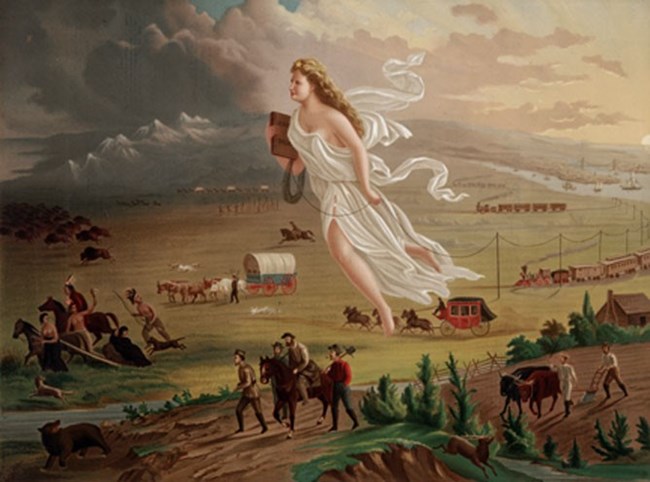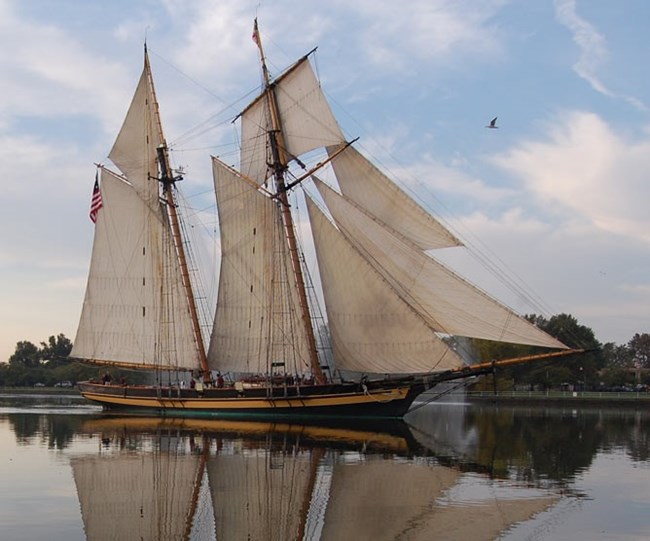
John Gast, Library of Congress Great Britain was satisfied with the status quo. For most of the war it had held the upper hand, including a successful invasion of Maryland and the occupation of the US capital city. Britain retained her North American possessions and actually gained new loyalty within the Canadas where the war united French-speaking and English-speaking colonies against American aggression. War weary from decades of fighting elsewhere, the British decided that victory over the distant United States was not worth the mounting cost. For Upper and Lower Canada, the War of 1812 was a victory. The British North American colonists united with Great Britain and American Indian allies to resist the attempt by the United States to conquer its northern neighbor. The war reinforced the colonial Canadas’ ties to Great Britain while inspiring a movement that eventually led to an independent Canadian Confederation. The story was very different for American Indians, most of whom allied themselves with the British. They experienced some of the most brutal fighting of the war along the western and southern frontiers and in Upper Canada. Their great leader Tecumseh died in battle, and with him died the vision of a confederacy of native nations united to protect their territory and traditional ways of life. The Treaty of Ghent did nothing to restore Indian lands, and with the end of the war they lost their British allies. There was nothing to stem the devastating tide of westward expansion that followed the war. For the United States of America, the war was a coming of age. The young upstart nation was divided by political and sectional bickering when it brashly declared war on Great Britain in 1812. It was badly bruised on the homefront over nearly three years, but it emerged in 1815 a stronger, more united nation. Citizens began to refer to themselves as Americans, rather than citizens of a particular state, such as Virginians or Marylanders. Their country had new heroes, new symbols, new stories of patriotism, and a new generation of leaders. The “Era of Good Feelings” that followed the War of 1812 in the United States energized the nation. Its new-found confidence stimulated developments in manufacturing, transportation, central banking, national defense, and particularly territorial expansion. The war also brought new respect to the young nation from many of the older more powerful nations of the world. The costs of the war are impossible to calculate. For a nation forever changed by the experience, the benefits were priceless. 
War’s Impact on the ChesapeakeFor the Chesapeake region, recovery from the war was not so easy. The region began feeling the effects on its economy sooner than other parts of the country when the British blockaded the Chesapeake Bay early in 1813. The blockade effectively shut the region off from markets for tobacco and other trade goods. Even worse, the British attacked towns, plundered plantations, and torched tobacco stores throughout the region over an 18-month campaign of terror. The Chesapeake sustained more enemy raids and property losses than any other region in the war.Southern Maryland was hit the hardest. Property losses ran in the millions of dollars. Many homeowners in St. Mary’s County moved out of the state to begin new lives in Kentucky or elsewhere. Populations declined in other counties, too. For Maryland as a whole, the white population fell by nearly 35,000 between 1810 and 1820. The loss of slave labor during the war was also a factor in the slow recovery of the region’s plantation economy. As a strategy of war the British promised freedom to enslaved African Americans who would desert the plantations and join the British side. Several thousand former enslaved individuals escaped to British ships and camps, and many aided the British cause as Colonial Marines and scouts. For the former slaves who left with the British to new homes in Nova Scotia, the West Indies, or elsewhere in the British Empire, the War of 1812 was a passport to freedom. While the Chesapeake Region suffered most, it took particular pride in the outcome of the war. Out of the successful defense of Baltimore came two symbols of the new United States: the Star-Spangled Banner flag and the song that would become the national anthem. Two other symbols of the Chesapeake’s legacy in the War of 1812 endure today. Pride of Baltimore II, which sails the seas as a goodwill ambassador for Maryland, is a near replica of the Chasseur, one of the most daring and successful privateers in the war on the high seas. And Defenders Day continues to be commemorated in Maryland each September to honor the men and women who defended Baltimore and the nation in the War of 1812. |
Last updated: October 16, 2020
